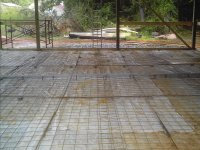smfcpacfp
Veteran Member
- Joined
- Nov 21, 2007
- Messages
- 1,346
- Tractor
- Kubota B3030HSDC
Several months ago, I started a thread about having a pole building built. It is going to be a Cleary building (30 by 48 by 14 feet) and appropriate for the kinds of snow loads (20 to 30 feet per year) we get in the UP of Michigan, and they will build it during the last week of October.
The proposed contract calls for 4" of concrete with wire mesh. I was wondering what you guys thought of this. The soil is pure beach sand, thus there is no heaving in the winter. I read somewhere that you should have 5 to 6" thick concrete if you are going to have heavy vehicles like the RV that will be stored in it.
As someone said either here, or elsewhere, it is cheaper to get concrete right the first time, than to redo it. So what would you guys want for concrete specifications?
The proposed contract calls for 4" of concrete with wire mesh. I was wondering what you guys thought of this. The soil is pure beach sand, thus there is no heaving in the winter. I read somewhere that you should have 5 to 6" thick concrete if you are going to have heavy vehicles like the RV that will be stored in it.
As someone said either here, or elsewhere, it is cheaper to get concrete right the first time, than to redo it. So what would you guys want for concrete specifications?
